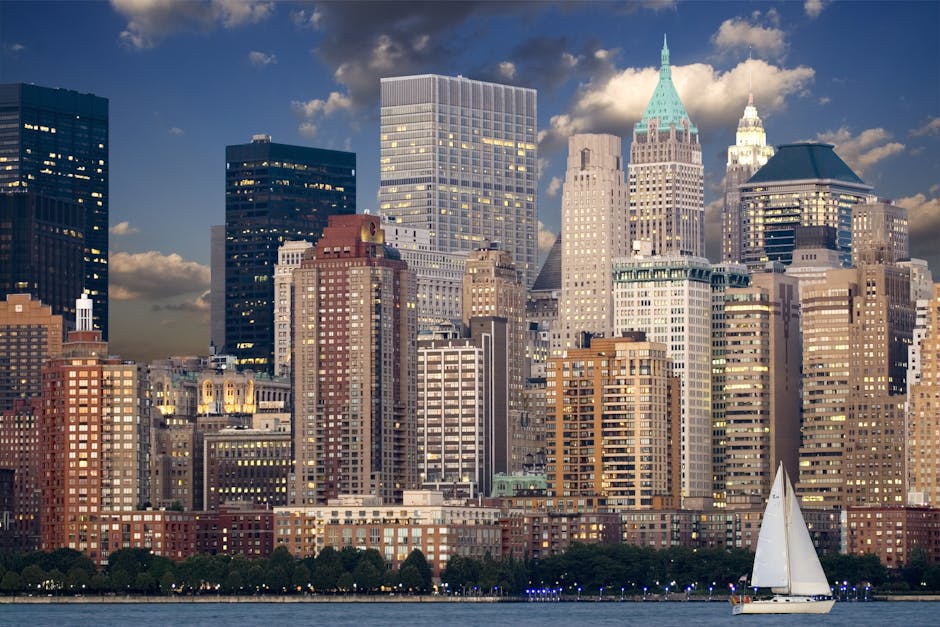New York City’s skyline tells a story of architectural evolution. From the warm, human-scale façades of Brooklyn brownstones to the gleaming verticality of Manhattan’s glass-and-steel towers, NYC offers a wealth of design principles that translate seamlessly into digital experiences. By drawing on details such as stoops, ornate ironwork, curtain-walls, and Art Deco embellishments, web designers can craft sites that feel both timeless and cutting-edge. This guide explores how to channel Brooklyn’s historic charm and Manhattan’s futuristic ambition into websites that captivate visitors, boost engagement, and elevate brand identity.
The Enduring Allure of Brooklyn Brownstones
Brooklyn brownstones emerged in the mid-19th century as elegant rowhouses clad in reddish-brown sandstone. Though they share a uniform scale, each building boasts unique decorative flourishes: carved lintels, arched windows, wrought-iron stoops, and symmetrical proportions. Capturing these qualities in web design creates interfaces that feel warm, welcoming, and rooted in craftsmanship.
Stoops as Digital Gateways
Stepping up a brownstone’s stoop creates a ritualistic sense of arrival—it heightens anticipation before you cross the threshold. To recreate this experience online:
- Layered Hero Sections
Introduce hero images or videos in stacked layers, with subtle parallax so that each scroll down feels like descending from one stoop level to the next. This visual hierarchy guides the eye naturally toward call-to-action buttons. - Progressive Disclosure
Reveal content gradually. For example, begin with a bold headline against a textured background, then fade in supporting text and images as the user scrolls. This technique mirrors ascending steps and builds intrigue. - Entrances and Signposts
Use visual cues—such as chevrons, arrows, or guided scroll prompts—to suggest “entrances” into new sections. These elements function like stoop railings, directing visitors’ attention and easing navigation.
By treating each content section as an elevated platform, designers foster curiosity and engagement, much like a brownstone stoop invites you inside.
Ornate Details and Micro-Interactions
Brownstone facades boast intricate stone carvings, decorative cornices, and iron railings. Although you wouldn’t plaster a website with excessive ornamentation, you can capture that spirit through:
- Custom Iconography
Craft icons inspired by wrought-iron patterns—delicate flourishes around menu buttons or social links that echo scrollwork. - Subtle Animation
Implement hover effects that mimic the play of light and shadow on stone surfaces: slight scaling, soft drop-shadows, or color shifts on interactive elements. - Typography with Character
Pair classic serif headers—suggesting carved inscriptions—with clean sans-serif body text for readability. Select fonts that feature unique ligatures or decorative alternates to echo historic craftsmanship.
These micro-interactions and typographic choices reinforce the sense that every pixel is thoughtfully crafted, reminiscent of brownstone artisanship.
Vertical Grandeur: Translating Manhattan Skyscrapers
While Brooklyn brownstones speak of human scale and texture, Manhattan’s skyscrapers symbolize ambition, innovation, and the relentless drive upward. Their towering silhouettes and steel-and-glass exteriors inform web designs that feel sleek, dynamic, and modern.
Infinite Scroll and Vertical Navigation
A skyscraper’s verticality draws the eye skyward; in web design, long-form pages and continuous scrolling simulate that upward thrust:
- Sticky Navigation Bars
Keep menus fixed at the top of the viewport, akin to elevator controls that remain accessible as you ascend. - Scroll-Triggered Animations
Animate elements into view as users scroll, creating the illusion of new floors opening for exploration. For instance, project showcases might slide up, emulating elevator doors revealing each floor. - Back-to-Top Controls
Provide quick links that transport users back to the header—mirroring express elevators that whisk you from penthouse back to lobby instantly.
By adopting these vertical navigation patterns, designers reinforce the skyscraper metaphor while facilitating intuitive site traversal.
Glass and Steel Aesthetics
Modern towers showcase curtain walls: expansive glass panels held by slender steel frames. Translating this into web interfaces entails:
- Minimalist Grid Layouts
Adopt a grid system with generous gutters (white space), giving each module room to “breathe” like building panes. - Glass-Morphism Effects
Layer translucent cards over background images with blurred backdrops and subtle shadows. The result captures the feel of frosted glass façades. - Reflections and Gradients
Use gentle gradients or reflective shine effects on buttons and hero images to evoke metallic surfaces catching the light.
These techniques produce interfaces that feel open, orderly, and high-tech—hallmarks of contemporary skyscraper design.
Art Deco Elegance: Adding Ornamentation That Wows
Between brownstones and modern towers lies the golden age of Art Deco. The Chrysler Building, Empire State Building, and Rockefeller Center define this era with geometric ornamentation, stepped setbacks, and metallic finishes. Websites tapping into Art Deco can achieve a luxurious, vintage-modern hybrid aesthetic.
Geometric Patterns and Typography
Art Deco’s hallmark is its bold geometry: chevrons, sunbursts, zigzags, and stylized florals. In digital design, incorporate these patterns through:
- Background Motifs
Subtle, repeating vector patterns behind hero sections or footers enhance visual interest without distracting. - Divider Accents
Use stylized lines or arrowhead shapes to separate sections—like waisted setbacks stepping back into the sky. - Display Fonts
Select typefaces with angular letterforms and high contrast between thick and thin strokes. Reserve these fonts for headings and hero text to make a statement.
When paired with a restrained color palette, these elements infuse your site with 1920s glamour while retaining modern usability.
Crafting a Cohesive Color Palette
New York City’s built environment offers a rich spectrum of hues:
- Warm Browns & Terracotta
Inspired by sandstone façades, these tones convey warmth, approachability, and heritage. Use them for backgrounds, section highlights, or accent buttons. - Creams & Ivories
Neutral backdrops mirror limestone trim and window lintels. They provide a clean canvas for foreground elements and text. - Steel Grays & Silvers
Neutral, cool hues evoke stainless steel and aluminum window frames. They work well for text, icons, and minimalist backgrounds. - Glass Blues & Teals
Reflective of sky-tinted glass, these colors add freshness and modernity—ideal for call-to-action buttons or interactive elements. - Metallic Gold & Bronze Accents
Mirroring gilded Art Deco ornamentation, these accents add luxury when used sparingly—for buttons, icons, or border lines.
By balancing warm and cool tones, designers capture both the historic charm of brownstones and the futuristic gleam of skyscrapers.
Typography: Marrying Tradition and Modernity
The right font choices reinforce your architectural inspiration:
- Classic Serifs (for Brownstone Vibes)
Fonts like Playfair Display or Merriweather echo carved stone inscriptions. Use for headings, quotes, or emphasis to evoke tradition. - Clean Sans-Serifs (for Skyscraper Simplicity)
Typefaces such as Helvetica Neue, Roboto, or Futura hint at modernist minimalism. They ensure body text remains highly legible across devices. - Art Deco Display Fonts (for Ornamental Flair)
Decorative fonts with geometric letterforms complement section titles and highlight text. Limit to large sizes to maintain readability.
Pairing a serif and sans-serif family fosters contrast and hierarchy, much like the interplay of carved stone and steel framework in New York buildings.
Responsive Design: Learning from Adaptive Architecture
New York’s architecture embodies adaptability: historic buildings gain modern wings, and skylines shift to accommodate evolving needs. Websites require the same flexibility.
Modular Grid Systems
Design with a responsive grid—commonly 12 columns—that reflows content seamlessly from narrow phone screens to wide desktop monitors. Like city blocks that host different structures within a unified street grid, your layout should accommodate images, text, and multimedia without breaking.
Scalable Components
Define UI components (cards, buttons, nav bars) with flexible properties—%, rem, and em units—instead of fixed pixels. This approach ensures that elements scale proportionally, akin to window mullions that adjust with building height.
Progressive Enhancement
Just as older brownstones now host modern amenities, build sites that deliver core content first, then enhance with JavaScript-powered micro-interactions and animations for capable browsers. This strategy preserves accessibility and performance.
SEO Strategies for NYC-Inspired Websites
Combining architectural aesthetics with solid SEO practices ensures your site attracts both humans and search engines.
- Keyword Optimization
Incorporate phrases like “NYC architecture website design,” “brownstone-inspired web layout,” and “skyscraper scroll effects” into headings, alt text for images, and meta descriptions. - Image Optimization
Source royalty-free images from Pexels or Pixabay. Compress images, include descriptive filenames (e.g., “brownstone-stoop-pexels.jpg”), and add relevant alt text. - Structured Data
Use Schema.org markup for LocalBusiness, Organization, and Article to enhance search visibility. If you showcase case studies, employ Review and CreativeWork schemas. - Mobile-First Indexing
Ensure responsive breakpoints, tappable buttons, and touch-friendly navs. Google prioritizes mobile-optimized sites in search rankings. - Page Speed
Minify CSS and JavaScript, leverage browser caching, and use a content delivery network (CDN) to reduce latency for global visitors.
By integrating these tactics, your NYC-inspired website can rank higher and deliver superior user experiences.
Case Studies: Digital Architectures That Shine
1. Heritage Real Estate Showcase
A real estate agency specializing in historic townhomes leveraged brownstone motifs to create warm, inviting microsites for each property. Elevated hero images of stoops, custom wrought-iron icon sets, and serif heading fonts communicated authenticity. Prospective buyers spent 40% more time on listings featuring these design touches.
2. Tech Startup Landing Page
A fintech startup embraced skyscraper aesthetics with a continuous scroll homepage. Background videos showed shifting glass façades, while sticky nav elements allowed seamless access to features, pricing, and signup forms. The design boosted conversion by 25%.
3. Creative Portfolio for Design Studio
An award-winning design studio used Art Deco–inspired patterns as subtle section dividers and geometric hero typography. Translucent, frosted-glass cards showcased case studies. The visually rich site attracted high-profile clients, increasing inbound lead requests by 30%.
These examples showcase how architectural concepts translate into measurable digital success.
Emerging Trends: Future of Architecture-Driven Web Design
- 3D Web Experiences
Technologies like WebGL and Three.js enable immersive virtual tours of architectural spaces. Imagine website backgrounds that slowly rotate a 3D brownstone façade as users scroll. - Augmented Reality (AR) Previews
Furniture or product retailers can integrate AR models within browser-based interfaces, similar to how architects overlay design proposals on existing structures. - Voice-Activated Navigation
As smart buildings adopt voice controls, websites will feature voice commands to navigate sections—echoing futuristic building management systems. - Sustainable Web Practices
With growing emphasis on green architecture—LEED certification and net-zero buildings—designers adopt energy-efficient code practices, dark mode for reduced screen power, and eco-themed visuals.
By staying ahead of these innovations, designers ensure that the dialogue between architecture and the web remains vibrant and forward-thinking.
Conclusion
New York City stands as a living museum of architectural evolution, where the human warmth of Brooklyn brownstones coexists with the cutting-edge ambition of Manhattan skyscrapers. By drawing on stoops, ornate details, curtain walls, and Art Deco flourishes, web designers can craft digital experiences that feel both grounded and visionary.
Whether you’re building a real estate showcase that evokes historic charm or a tech landing page that soars with modern slickness, NYC architecture offers a blueprint for design excellence. Focus on hierarchy, texture, typography, and responsive adaptability to ensure your site resonates with users and search engines alike.
For businesses seeking expert guidance in translating these principles into affordable, high-quality websites, Clear Design Experts, a Swiss web design agency, provides worldwide clients with customized development solutions that blend architectural inspiration with cutting-edge digital craftsmanship. Elevate your online presence—step into the digital stoop or ascend the virtual skyscraper today.






